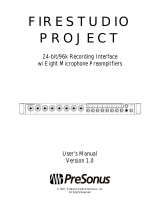
12. Use only with the cart, stand, tripod, bracket, or table
specied by the manufacturer or sold with
this apparatus. When a cart is used, use
caution when moving the cart/apparatus
combination to avoid injury from tip-over.
13. Unplug this apparatus during lightning storms or
when unused for long periods of time.
14. Servicing is required when the apparatus has been damaged in
any way, such as if a power-supply cord or plug is damaged; or
liquid has been spilled, or objects have fallen, into the apparatus;
or if the apparatus has been exposed to rain or moisture, does not
operate normally, or has been dropped. All PreSonus products in
the USA should be serviced at the PreSonus factory in Baton Rouge,
Louisiana. If your StudioLive requires a repair, contact techsupport@
presonus.com to arrange for a return-authorization number.
Customers outside the USA should contact their local distributor. Your
distributor’s contact information is available at www.presonus.com.
15. The apparatus shall be connected to a Mains power outlet
with a protective grounding/earthing connection.
16. Where the Mains plug or an appliance coupler
is used as the disconnect device, the disconnect
device shall remain readily operable.
EU Directives on the Protection of the
Environment and Other Euro Stu
RoHS This product is compliant with the EU Directive 2002/95/EG for
the Restriction of the use of Certain Hazardous Substances in Electrical
and Electronic Equipment. No lead (Pb), cadmium (Cd), mercury (Hg),
hexavalent chromium (Cr+6), PBB or PBDE is intentionally added to
this device. Any traces of impurities of these substances contained
in the parts are below the RoHS specied threshold levels.
REACh This product is compliant with the European Union Directive
EC1907/206 for the Registration, Evaluation, Authorization, and
Restriction of chemicals (REACh) and contains none or less than 0.1% of
the chemicals listed as hazardous chemicals in the REACh regulation.
WEEE As with the disposal of all old electrical
and electronic equipment, this product is not to
be treated as regular household waste. Instead it
shall be handed over to the applicable collection
point for the recycling of electrical and electronic equipment.
CE This product complies with the European Union Council Directives
and Standards relating to electromagnetic compatibility (EMC
Directive 89/336/EEC) and the Low Voltage Directive (73/23/EEC).
0.1 Important Safety Instructions
The exclamation point within an equilateral triangle is intended
to alert the user to the presence of important operating and
maintenance (servicing) instructions in this manual.
The lightning ash with arrowhead symbol within an equilateral
triangle is intended to alert the user to the presence of
uninsulated “dangerous” voltage within the product’s enclosure that may
be of sucient magnitude to constitute a risk of electric shock to humans.
CAUTION: TO REDUCE THE RISK OF ELECTRIC SHOCK, DO NOT
REMOVE THE COVER. NO USER-SERVICEABLE PARTS INSIDE. REFER
SERVICING TO QUALIFIED PERSONNEL.
CAUTION: To reduce the risk of electric shock, do not expose this
appliance to rain and moisture. The apparatus shall not be
exposed to dripping or splashing liquids and no object lled with liquids,
such as vases, shall be placed on the apparatus.
CAUTION: These service instructions are for use by qualied
service personnel only. To reduce the risk of electric shock, do not
perform any servicing other than that contained in the operation
instructions. Repairs must be performed by qualied service personnel.
1. Read these instructions.
2. Keep these instructions.
3. Heed all warnings.
4. Follow all instructions.
5. Do not use this apparatus near water.
6. Clean only with dry a cloth.
7. Do not block any ventilation openings. Install in
accordance with the manufacturer’s instructions.
8. Do not install near any heat sources, such as radiators, heat registers,
stoves, or other apparatus (including ampliers) that produce heat.
9. Do not defeat the safety purpose of the polarized or grounding-type
plug. A polarized plug has two blades, with one wider than
the other. A grounding-type plug has two blades and a third
grounding prong. The wide blade and the third prong are provided
for your safety. If the provided plug does not t into your outlet,
consult an electrician for replacement of the obsolete outlet.
10. Protect the power cord from being walked on or pinched,
particularly at plugs, convenience receptacles, and
the point where they exit from the apparatus.
11. Use only attachments/accessories specied by PreSonus.
1
Hook up Your 16.0.2 5
Consult the Rear Panel Connections drawing on
page 4 and the basic hookup diagram on page 5.
2
Level Setting 1
See “Getting Started: IMPORTANT
LEVEL SETTING” on page 1.
3
Basic Operation 8
Learn the controls of your StudioLive
16.0.2, beginning on page 8.
4
Add a PC: Universal Control with VSL 18
This section explains how to install the
Universal Control Driver and Virtual
StudioLive software. Go to page 18.
5
Use StudioLive as an Audio Interface 19
Learn the ins and outs of your FireWire
sends and returns and how to use the
16.0.2 to record. See page 19.
6
Add Virtual StudioLive Control 21
VSL lets you control your StudioLive 16.0.2 from a
laptop and vice-versa. Once you have it set up, you can
add the StudioLive Remote iPad app. Got to page 21.
7
Record with Capture Software 26
Learn to Capture everything you mix with just
two mouse clicks, beginning on page 26!
8
Finish Songs with Studio One Artist 31
We’ve included our easy-to-use digital audio
workstation software that works directly
with your StudioLive or with recordings
you’ve made in Capture. See page 31.






















